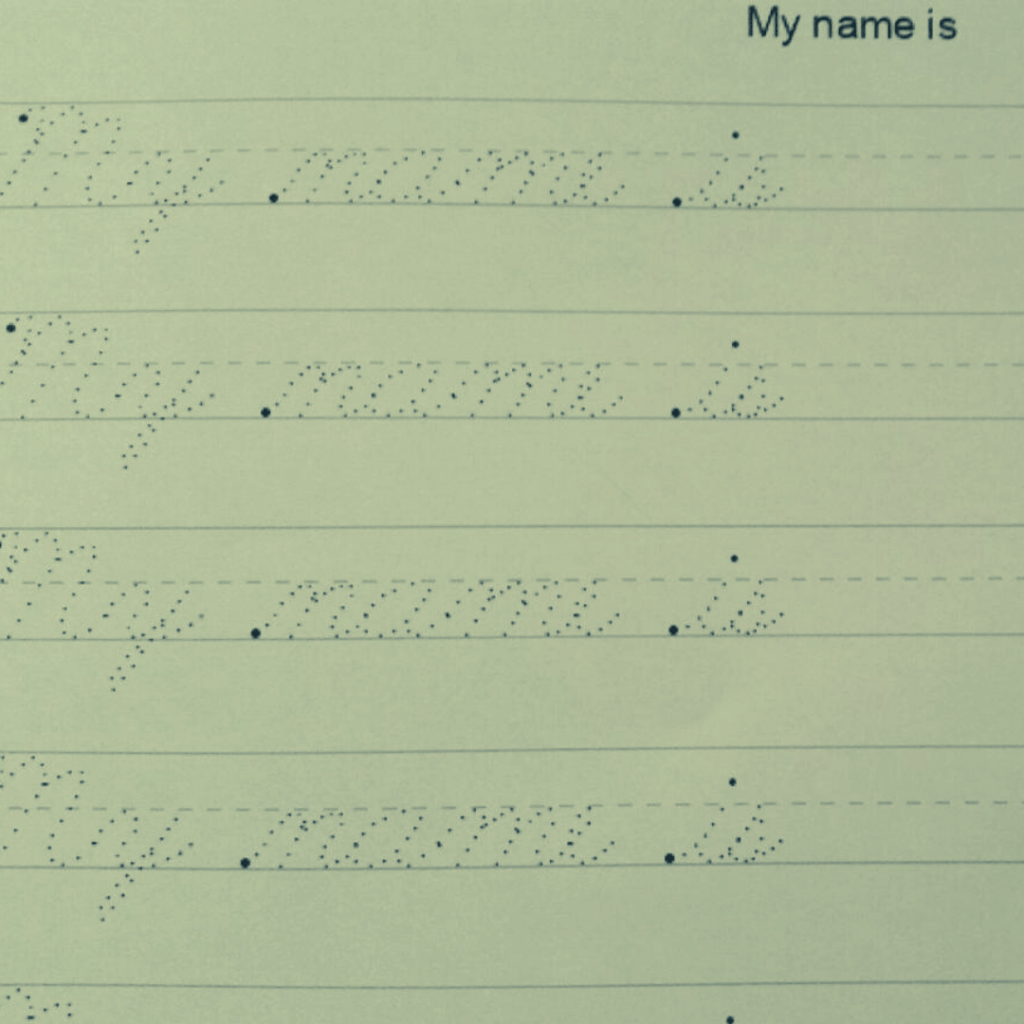
This can be filed under “something else I was blissfully unaware of.”
A recent TV news segment one morning caught my eye, and it was about something that I had never pondered. The caption read: Twenty-one states (up from 14) require students to learn to write in cursive. I was gobsmacked—not because the number of states had increased. No, I was shocked at this account because I did not know it was a “thing.”
The last time I had to think about cursive handwriting was when it was time to teach my daughter, who has autism, to write in preparation for first grade. She had been practicing printing letters and was making good progress at her charter school, but I knew that her new teacher would be required to start a cursive curriculum. Because of this, the summer before she was to start first grade, her therapists and I taught her. She was already required to sit for two to three hours at a time (also indicative of this first-grade class), so in addition to her other programs, writing in cursive was incorporated. She learned easily, and by the time she entered the first grade, her cursive was impressive.
My research on this subject has, of course, exposed pros and cons on the teaching and use of cursive handwriting, and the nearly twenty tabs opened in my browser is a small sampling of the information found online. If I acquiesce to my experience and, therefore, my bias, I must confess that I am in favor of the teaching of cursive handwriting. But not for most of the reasons I unearth on myriad sites. My reason is a practical one: this day alone I used my cursive to write checks and address envelopes. Now, normally I pay bills online, but when I prepared to pay some medical bills recently, two offices did not recognize my information and one site sent me to another payment page that looked dodgy at best. I don’t usually write checks (and the only other recent checks I have written were to the illustrator of my forthcoming book who prefers this method of payment), so I had to concentrate on making my handwriting especially legible. Obviously, I could print the address information on the envelopes, but since I have always used cursive for this task, no debate exists for me.

The Common Core standards ended the requirement to teach children cursive in 2010, and since that time lawmakers in a variety of states have introduced bills to return cursive instruction to the classroom. Some reasons given for this exercise are sketchy and include the desire to preserve the ability to read the Constitution and the Declaration of Independence (a strange argument, since the script makes it hard for many people to interpret), the fear that one might be perceived as “uneducated” if one was not able to write in the cursive style, and the belief that learning cursive is a way to prove you are an American (Louisiana state senators shouted “America!” when they approved the bill to return the teaching of cursive to the classrooms). But according to this New York Times article, some lawmakers may have had nefarious reasons for pushing the legislation.
Most people revert to their own experiences when offering opinions on socially-relevant topics (just as I did above), and the public debate (websites, comment sections, legislature) of whether to require the teaching of cursive in elementary schools is a fine example of this. So even though my reasons for teaching my daughter cursive were borne out of necessity (required by school, peer pressure), other global, if not altruistic, rationales exist. Following are a few examples:
Learning cursive aids cognitive and fine-motor development
Studies have shown that cursive writing enhances the way the left and right sides of the brain work together. Higher scores have been reported in first-grade students who learned to write in cursive, and one theory is that the uninterrupted flow of writing words develops a way for the brain to merge sensation, movement control and thinking. Brain imaging has shown that several parts of the brain work together when children practice cursive, and the added benefit of applying the dexterity necessary for joined-letter writing can improve fine motor skills and reading competency.
Taking notes in cursive can help you retain information
A student’s note-taking method can determine how deeply the material is understood. When the information is taken down in cursive, the brain must determine the important details and record them quickly. If the notetaker is keyboarding everything said (and I can attest that this is how I record notes using my laptop), learning is more superficial, and subtleties may be lost.

Learning and using cursive might save your skin someday!
Although I adore science, I’m done writing about the academic and technical benefits of writing in cursive. Altruism aside, I must add that the very first book I wrote (well, I have about two-thirds completed, and I hope to finish this year) was written in cursive. Mind you, this was almost twenty years ago, and I did not yet have a laptop, so perhaps that is the reason. But I do remember taking my notebook with me and writing whenever I had a few moments to spare or whenever I would suddenly think up a “clever” new twist or some “crafty” dialogue. But the reason why I am thrilled that I wrote this book in cursive is that I still have it: all five notebooks in various sizes and thicknesses. I am in the process of transcribing them now (I have to say that trying to read my own writing after 20 odd years is sometimes not easy). If I had started this book on my old, clunky computer with the ancient tower, it would now be one with my two screenplays and various one-act plays I wrote at about the same time. In other words, it would be no more.
During my research, I stumbled upon a site called Campaign for Cursive, a non-profit group of volunteers passionate about their cause. I had fully intended to outline some of the reasons people have for wanting to abolish the teaching of cursive, but their site includes a link to their white paper, and the writers did a pretty good job of presenting the pros and cons.
I’m glad that my daughter learned cursive, but this was in the ‘90s when teaching it was still the norm. Even if it had not been required, I would have made sure to incorporate this skill into her curriculum, as she has utilized it signing medical forms and voter i.d. cards, taking college classes and in the ability to read cursive. Though maybe not always: I asked my daughter a while ago if she would be willing to transcribe some of my book. She looked at the notebook for a moment, shook her head, and handed it back to me with a curt: “Can’t read it.”
Apparently, I really do need to brush up on my cursive.
Featured Photo by Debby Hudson on Unsplash.


Yesterday I read that so many unemployment claims have been submitted that there is a search going on for those with knowledge of older computer languages. No one defined the search, but I assume they are looking for pre-Windows knowledge – DOS.
Who can say what demands the future will bring?
LikeLike